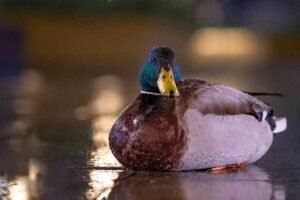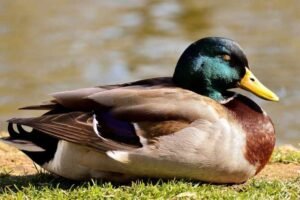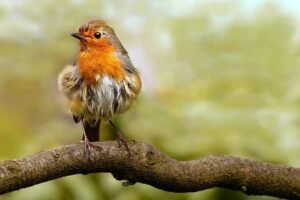Soaked mealworms are an increasingly popular form of food used for wild garden birds. These are highly beneficial especially during the breeding and the fledgling season when there is fierce competition amongst birds for natural resources like earthworms.
This high demand and competition can be minimized with the help of certain human interventions i.e. feeding of soaked mealworms. These worms are easily available in dried or fresh form either in your local stores or online.
Soaked mealworms are considered a delicacy for wild garden birds. Other than this mealworms have a high nutritious value and are especially useful for providing a complementary diet rich in essential proteins and fats.
Now the question arises that should you offer your wild birds dried our mealworms or soak them in water? Or what offers greater benefits?. The answer is both forms have somewhat equal benefits, however, soaking them in warm water for 30 minutes before you offer them out is a brilliant way to give your garden birds some extra hydration.
Soaking dried mealworms can also make them easier to digest for your birds and also easier to break apart from smaller birds or birds with softer beaks.
Another advantage of feeding soaked mealworms is that it gives bird fanciers a new way to capture their backyard wild birds’ interests. Mealworms make a terrific treat. Whether the mealworms are soaked, dried, or live, they are nutritious and popular with most outdoor wild birds.
Now we tackle some important questions like Why feed wild birds soaked mealworms? How often? Which types of bird feeders are best for mealworms?, which species enjoy mealworms, And how do you store mealworms?
What are mealworms?
Mealworms come from a family of beetles Tenbrio Molitor, which is a sub-species of darkling beetle. There is a common lifecycle, or series of four stages, through which mealworms go before entering adulthood. These are:
1) egg,
2) larva
3) pupa
4) adult
Tenebrio Molitor is a prolific breeder and can lay up to 500-600 eggs at a time. This astounding number is enforced due to external pressures from predators. Mealworms are also commons targets for numerous species, including reptiles. Depending on the larvae’s environment, it can take anywhere between three and thirty days for the mealworm to emerge as a beetle.
WHAT BIRDS WILL EAT MEALWORMS?
Different Insectivorous wild birds such as Robins, Wrens, Tits, Blackbirds, and Wagtails all love to eat soaked mealworms. If you are lucky enough to live in a rural or farmland area then you might see a Thrush or Fieldfare stopping by for a juicy worm snack.
DO I HAVE TO SOAK and Rehydrate DRIED MEALWORMS FIRST?
It is not mandatory to soak your dried mealworms in water before you use them. However, soaking them in warm water for 30 minutes before you offer them out is an excellent way to give your garden birds some extra hydration.
Soaking them can assist in the bird’s digestion and also make it easier for smaller birds or birds with softer beaks to break them apart.
What Are The Benefits of Feeding Meal Worms to Wild Birds?
Mealworms are basically the larvae stage of Darkling Beetles. These cream-colored grubs are high in protein and fats. In the winter season, wild birds need extra fat to stay warm. They also need extra protein when they are:
- young and in the growing phase
- laying on feathers
- preparing to lay eggs
- feeding their chicks
New parents will feed seeds to their youngsters in the nest. Most wild birds prefer to provide insects to their babies. Mealworms are their most favorite out of all these.
Dried Mealworms are excellent for wild birds all year round as they are rich in protein, fats, and fiber. Dried Mealworms that have been soaked in water have additional benefits as it is a fantastic source of hydration, particularly in hot summer months. There are several methods of hydrating mealworms which we will see later on.
What is The Frequency of Feeding Mealworms to Wild Birds?
Mealworms should be used as a treat for wild birds. Therefore, you can occasionally offer live mealworms in small quantities. Your wild birds will mostly depend upon bird feeders stocked with seeds. This all depends upon whether you feed year-round or just in the cold seasons.
During the spring season, you can increase the frequency at which you feed mealworms. Proteins greatly assist birds in laying eggs and feeding youngsters.
If you are just feeding dried mealworms: they can be offered year-round but in limited quantities. You can place dried mealworms in their feeder or mix them in with suet or seed mix.
Your birds might not like the dried mealworms right away. You can tempt the birds to start eating them by moistening them. This will make mealworms more appealing. However, do not leave soaked mealworms out for more than a day or two.
What is The Serving Size of Mealworms?
Once the birds know where the mealworms are placed you can expect to go through about 100 per day. But remember these protein-packed snacks are only a supplement to their diets, so following a fixed serving amount is not necessary.
CAN I MIX SOAKED MEALWORMS WITH JUST BIRD SEED?
Mixing Soaked mealworms with birdseed fantastic way to offer a variety of healthy foods to your wild birds. Mealworms on their own are low in calcium and do not offer birds balanced nutrition.
Try mixing your worms with other straight seeds for an all-around diet or suet products for a more nutritious diet.
Which is Better: Soaked, Dried, or Live Mealworms?
This decision is entirely up to you. There are pros and cons to each method. Live mealworms are most appealing to birds but they are expensive and require work to maintain. Dried mealworms are low-cost and convenient, yet may not be as effective at catching birds’ eyes. Whereas soaked mealworms require a bit more effort as compared to the dried variety.
How to Offer Soaked Mealworms to Birds?
Rather than simply scattering mealworms on the ground, place them on a platform feeder to keep them contained and fresh. The feeders should be placed near vegetation and away from windows. These are the types of bird feeders you need in your yard.
What Are Cheap Ways to Serve Mealworms?
There are several cheap ways you cut costs and serve your wild birds with delicious mealworms.
- Consider making your feeder simply by recycling old kitchen pans or dishes.
- For long-term savings, buy live larvae in bulk from online or local bird food suppliers.
- You can also raise them yourself for a perpetual source.
What Are The Different Variations of Mealworm Food for Birds?
There are two types of commercially available mealworms for wild garden birds
- Dried mealworms
- Live mealworms
Dried mealworms
Dried mealworms usually come in bag sizes of between 100g and 5kg. They are extremely easy to store way, dried mealworms can easily be soaked in warm water overnight to rehydrate them for an extra juicy bird treat. They are also useful for scattering on bird tables and over the ground.
Live mealworms
Live Mealworms are the most obvious choice for the freshest wild bird treat. These can be ordered online and can be kept alive for up to several weeks. This however all depends upon the environment in which the mealworms are kept.
What Are The Best Feeder Types for Wild Garden Birds?
When it comes to the best feeders to feed mealworms wild garden birds, there are no obvious choices. Some bird fanciers use simple, homemade bird feeding trays. However, the best types of mealworm feeders will have these characteristics:
- Sides should be tall enough so the mealworms don’t crawl out
- A roof or rain guard
- Drainage holes
- Some form of tamper-resistant features
If you are buying a feeder always remember to purchase one where the feeding area is protected from rain, so the mealworms don’t drown or get moldy in a downpour. In case some water gets in through the drainage holes. Always place the feeder where it discourages squirrels from getting in.
Most hanging birdfeeders are also suitable. Bird feeders with squirrel-resistant roofs and lids also protect the food from rain and other external elements. Ideally, place the mealworms on a tray. Laying them out helps the birds spot the wiggling live mealworms and easily get at them.
If you are feeding mealworms to wild birds regularly, they will be consumed almost immediately before they turn into pupae or beetles. If you spot pupae or beetles in there, simply release them outside.
How Do I Soak & Rehydrate Dried Mealworms?
Dried mealworms are great to feed wild birds. Especially in hot summer months, when the water is scarce, soaked mealworms are a great way to keep the wild birds hydrated. Although you should always have plenty of water readily available in your garden or farmland. But the most prolific advantage of soaked mealworms is that keeps the birds even more hydrated and that is by rehydrating their dried mealworms before they feed on them.
How to rehydrate your freeze-dried mealworms?
- First, place your dried mealworms in a container that you don’t mind getting dirty.
- Pour a few cups of water into a boiler in a pan on your stove.
- Once the water starts boiling, pour the water over the dried mealworms.
- Add enough water so that all of the dried mealworms are covered evenly, you can expect some worms to float to the top.
- Leave the mealworms soaked in the water for at least 30 minutes.
- During this time, the dried mealworms will soak up as much water as possible.
- Once the worms have reached their soaking potential they will swell in size and change to a pale color.
- After about 30 minutes, your dried mealworms should be rehydrated and ready to serve.
- Another way you can know that they are ready is by picking mealworms individually and notice that they are very flexible.
- After this place the rehydrated mealworms in a limited quantity in your bird feeder.
- Make sure you place only the amount of mealworms that can be easily consumed by the birds.
How Do I Store Mealworms?
How you store your mealworms depends entirely upon whether they are dead or alive.
For dried mealworms, you can simply keep them sealed in their bag. Dried mealworms will last a very long time if stored without air circulation.
Live mealworms can last several months but you need to keep them cool. Warm mealworms will mature quickly into pupae and then beetles. Keep them at a temperature of about 40 degrees. Since this is the temperature of a typical refrigerator, put them in the fridge.
You can make the mealworms grow a bit by feeding them before refrigeration. A good diet for growth includes small slices of potato, fresh carrot pieces, and little bits of the orange rind. Never add more than they can eat before it gets moldy. Moldy food will make your mealworms die. When they have fattened up a bit, put them in the fridge and they will go dormant.
An ideal home for mealworms is either a plastic container about the size of a shoebox with a lid. For air punch very small holes in the top. Wheat bran can be used as bedding.
Once you have received your live mealworms place them in the container, then add enough wheat bran to half-fill the container. Keep some space between the mealworms and the lid, so that it discourages escapes.
Can I breed my mealworms?
Yes, of course, you can breed your mealworms. Especially if you’re on a tight budget and have the time and patience for doing. There is a lot of advice on how to do so on the internet.
Where can I buy mealworms for my wild birds?
You can buy mealworms from amazon for your wild birds or from your local pet stores. They usually keep a selection of fresh live mealworms and dried mealworms.





